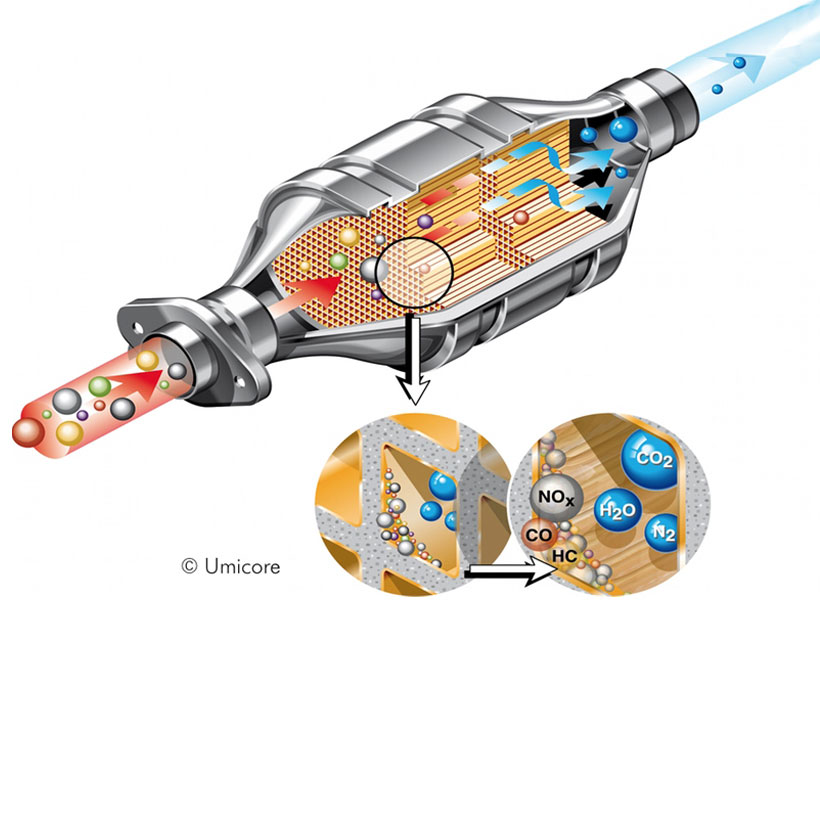Catalytic converters
Almost all PGM demand in the automotive sector derives from autocatalysts or catalytic converters on ICE (internal combustion engine) vehicles. Platinum, rhodium and/or palladium are coated onto a substrate housed in the exhaust system and act as catalysts to reduce levels of carbon monoxide (CO), hydrocarbons (HC) and oxides of nitrogen (NOx) to legislated levels.
The automotive sector still makes up more than 80% of total demand for palladium and rhodium, although it is expected to decrease in the long term with the rise of zero-emissions vehicles. However, with battery electric vehicles rolling out more slowly than expected, automakers still augment their output of gasoline cars (both hybrid and conventional) equipped with catalytic converters to meet strong consumer demand for vehicles.

Key Facts:
- Just one car sold in the 1960s would have produced as many harmful exhaust emissions as over one hundred of today's automobiles equipped with catalytic converters.
- Without autocatalysts, air quality in and around most cities would be far worse than it is today: An autocatalyst installed on a Euro 6d-temp vehicle helps to avoid over 1.3 tonnes of toxic and harmful polluting gases (Source: IPA LCA 2017) over its lifetime.
- Autocatalysts convert over 90% of harmful polluting gases into less harmful carbon dioxide (CO2) and water vapour.
- Due to the catalytic properties of PGMs it has been possible for legislators to mitigate the effects of exhaust pollution from increasing numbers of vehicles on our roads.
- The increasing use of catalytic converters required the introduction of more sophisticated engine control technologies. These have allowed automobile manufacturers to design engines for higher fuel efficiency, promoting a continuous rise in fuel economy which will continue to be important as manufacturers strive to meet more demanding fuel economy and CO2 regulations.
What is an autocatalyst?
An autocatalyst is a cylinder or elliptical cross section made from ceramic or metal formed into a fine honeycomb and coated with a solution of chemicals and a combination of platinum, rhodium and/or palladium. It is mounted inside a stainless-steel canister (the whole assembly is called a catalytic converter) and installed in a vehicle's exhaust line where it converts pollutants from the combustion of fuel into harmless gases.
In a catalyst system for gasoline engines, as exhaust passes through the device, the autocatalyst converts gaseous HC, CO and NOx into water, CO2 and nitrogen. A catalyst system for diesel engines additionally employs a filter to eliminate fine particulates (soot) which are a significant cause of lung and cardiovascular disease. The DPF (diesel particulate filter) traps these particulates and is usually coated with PGMs to help to burn them off and regenerate the filter. Similarly, Gasoline Particulate Filters (GPF) are used to remove particulate matter from the exhaust gas from a gasoline direct injection (GDI) engine.
Diesel engines operate at lower temperatures than gasoline engines and run with a leaner gas stream containing lots of oxygen. Under these conditions platinum is a more active catalyst for the conversion of CO and hydrocarbons to harmless emissions. However, the addition of some palladium to the platinum catalyst can improve its thermal stability. This is an advantage when reducing diesel particulate matter from the exhaust. This process involves trapping the PM, or soot, in a filter and then raising the temperature of the system to oxidise the soot to CO2. At these higher temperatures palladium improves the thermal durability of the catalyst, helping it perform optimally for the lifetime of the vehicle.
Without PGMs, the desired conversion reactions in the catalytic converter would not take place, resulting in the vehicle not meeting the emissions regulations. Other materials have been tried but have not met the long-term activity and durability requirements of modern-day emission control systems.
The activity of the PGMs enables the reactions to occur at low temperature conditions that exist during cold starting of a vehicle, when emissions are at their highest. Durability is important since catalytic converters need to perform over the life of the vehicle. It also means that when an automobile is scrapped the precious metal contained in the catalytic converter is available for recycling, creating a valuable supplementary source to mining to produce new autocatalysts.
The implementation and subsequent tightening of Real Driving Emissions (RDE) regulations in Europe between 2017 and 2023 have resulted in a rise of gasoline loadings of more than 60% (source: Johnson Matthey PGM Market Report May 2024, p. 10). One of the main reasons for higher loadings under Euro 6d RDE regulations is the need to achieve good NOx, carbon monoxide and hydrocarbon conversion at low temperatures, such as during cold-start and in a city-driving environment.
In the heavy-duty sector, the increase in the production of large trucks powered by compressed natural gas (CNG) leads to more PGMs being used in the gasoline-type catalyst technology on these vehicles, as these require much higher PGM loadings than other powertrains.






